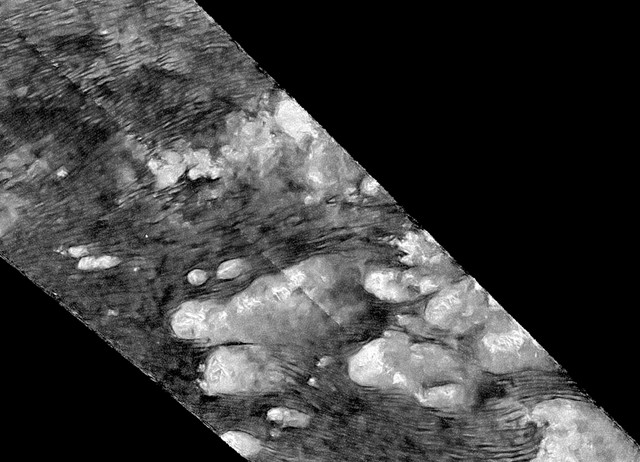
by Mara Johnson-Groh Tuesday, October 16, 2018

New research reveals that Titan has dunes that form much like those on Earth. Credit: NASA/JPL-Caltech/ASI/Université Paris-Diderot.
The mountains of East Xanadu rise high above the windswept plains and dunes of Shangri-La. This fantastical landscape isn’t found in a scene from a Hollywood movie, or even a desert on Earth, but on Titan, Saturn’s largest moon. New research looking at the surface topography of Titan — more than a billion kilometers from Earth — reveals it has a lot in common with our planet. The work, published in the Journal of Geophysical Research: Planets, shows that the dunes likely formed in a process that’s analogous to how dunes form on Earth — through weathering, erosion and deposition.
From 2004 to 2017, NASA’s Cassini spacecraft studied Saturn and its satellites, sending back countless images of Titan taken with visible, infrared and radar cameras. Jeremy Brossier, a doctoral student at the German Aerospace Center, and his colleagues used this imagery to map Titan’s equatorial regions, finding that the moon’s dunes are formidable and range across millions of kilometers more than previously thought. They also studied transition regions on the surface where dunes border mountains or craters, using radar to infer and distinguish different landscape features — mountains, craters, dunes and ice beds, for example. Additionally, infrared imagery helped the scientists determine grain sizes and compositions of particles at each location, essential for teasing out the geologic processes that formed them.
The researchers found that the dune-forming process begins high above Titan’s surface in its dense atmosphere of gaseous methane and nitrogen. When methane rains fall, they bring with them a fine coat of tholins — complex organic molecules formed by irradiation of cosmically abundant gases or ices. (Tholins were discovered and named in 1979 by Carl Sagan and Bishun Khare, who suggested the sticky solids could also aptly be named “star-tar.”) As the liquid hydrocarbon rain erodes mountaintops and craters, forming canyons and channels, the runoff carries pieces of ice and tholins. Over time, winds sweep away the smaller grains, which eventually form the dunes that cover 18.6 percent of Titan’s surface. This process is similar to how dunes are created on Earth, with the exception that the particles on Titan are initially formed in the atmosphere rather than on the ground. “The tholins composing the dunes … are themselves formed through photochemical reactions involving hydrocarbon gases and dinitrogen,” Brossier says. “By knowing how the dunes are formed, we understand part of [the hydrocarbon] cycle on Titan, at least the interactions between the atmosphere and surface of the moon.”
Titan’s nitrogen-rich atmosphere might be hospitable to life, so understanding the moon’s geological processes may help scientists in their search for extraterrestrial life. The researchers also suggested their results offer evidence of water ice in some areas, an observation that has been largely speculative based on previous work.
However, “this is not the first time a plausible sign of water ice has been seen in [the Visual and Infrared Mapping Spectrometer, or VIMS] data,” says Juan Lora, a planetary climatologist at UCLA who was not involved in the study. “The combination of VIMS’ low resolution and Titan’s obscuring atmosphere means that definitive spectral detections of the surface are just not possible with these data.”
The dry, desert-like dune landscapes studied in this work are in Titan’s equatorial region. Eventually, Brossier says, future studies using similar techniques could help scientists understand Titan’s polar regions, where most of the moon’s methane rainfall occurs, providing a fuller picture of the planet’s hydrocarbon cycle.
© 2008-2021. All rights reserved. Any copying, redistribution or retransmission of any of the contents of this service without the expressed written permission of the American Geosciences Institute is expressly prohibited. Click here for all copyright requests.